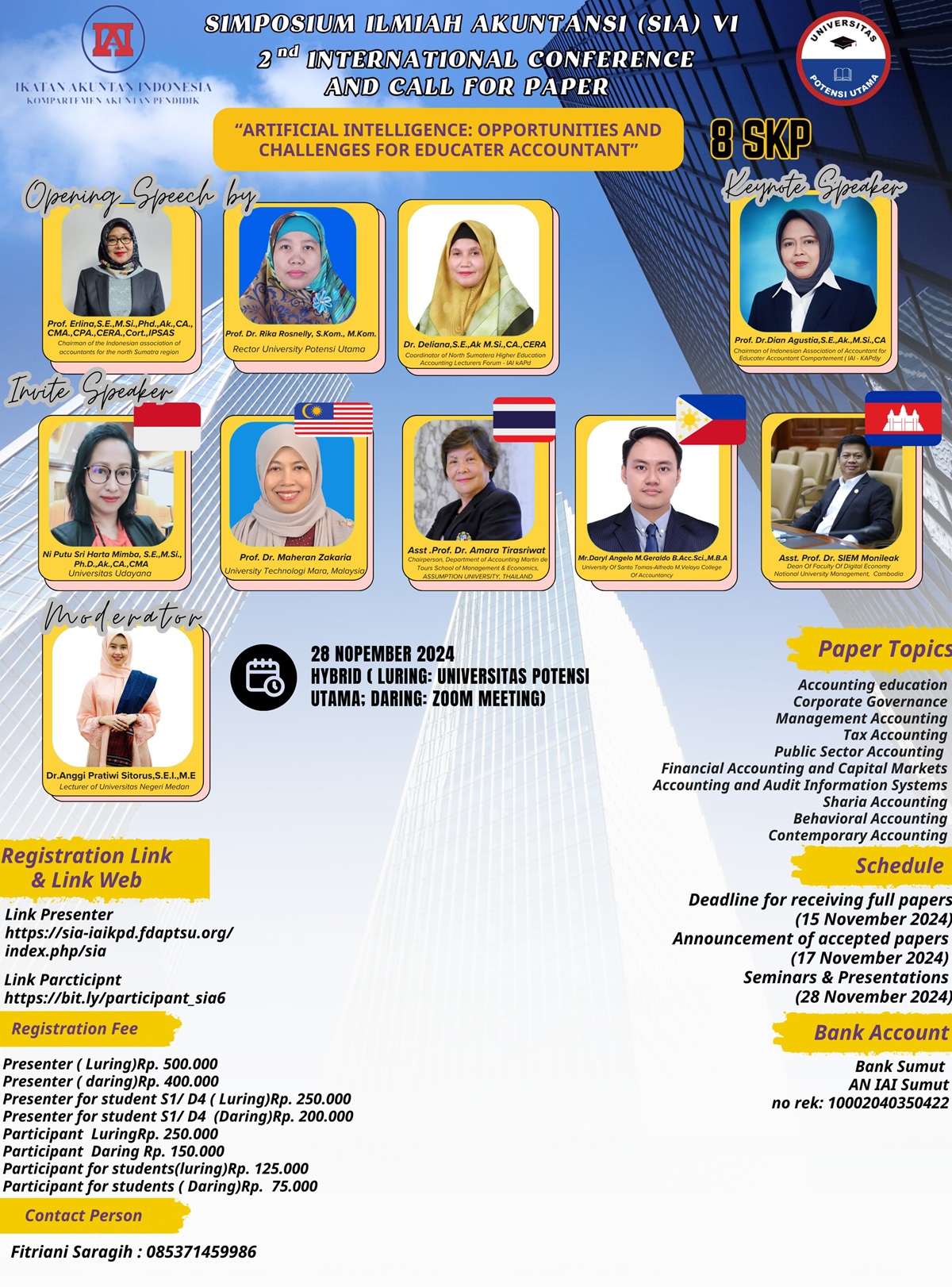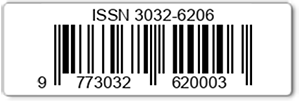The Effect Of Pentagon’s Fraud On Financial Statement Fraud
Keywords:
Fraudulent Financial StatementAbstract
Research on financial statement fraud is interesting to study because thera cases of accounting scandals that occur in publicly listed companies in Indonesia. This study aims to empirically examine the effect of the fraud pentagon in detecting fraudulent financial statements. The pentagon’s fraud theory is a development of the fraud triangle theory by adding elements of competence and arrogance. Fraud pentagon is proxied by seven variables consisting of three variables from the pressure element (financial stability, financial target and external pressure); one variable from the opportunity element (nature of industry); one variable from the rationalization element (total accrual); one variable from the competence element (change in director) and one variable from the element of arrogance (frequent number of CEO’s picture). F-Score model is used determine fraudulent financial statement. This research was conducted on companies listed in the LQ45 Index in the 2018-2022 period. By using multiple regression analysis, the results show that external pressure, nature of industry and total accrual have an effect on fraudulent financial statement.
References
AICPA. (2002). New Statements on Auditing Standards. Annual Update for Accountants and Auditors, 1719–1770.
Albrecht, W. S., Albrecht, C., & Albrecht, C. C. (2008). Current trends in fraud and its detection. Information Security Journal, 17(1), 2–12. https://doi.org/10.1080/19393550801934331
Albrecht, W. S., Albrecht, C. O., Albrecht, C. C., & Zimbelman, M. F. (2012). Fraud Examination. In South-Western Cengage Learning.
Bayagub, A., Zulfa, K., & Mustoffa, A. F. (2018). Analisis Elemen-elemen Fraud Pentagon Sebagai Determinan Fraudulent Financial Reporting (Studi pada Perusahaan Property dan Real Estate yang Terdaftar di Bursa Efek Indonesia Periode 2014-2016). Isoquant Jurnal: Ekonomi, Manajemen Dan Akuntansi, 2(1), 1–11.
Brennan, N. M., & McGrath, M. (2007). Financial Statement Fraud: Some Lessons from US and European Case Studies. Australian Accounting Review, 17(2), 49–61. https://doi.org/10.1111/j.1835-2561.2007.tb00443.x
Cressey, D. R. (1953). Other people’s Money: A study of the social psychology of embezzlement. In Glencoe, IL: Free Press.
Damayani, F., Wahyudi, T., & Yuniartie, E. (2017). Pengaruh Fraud Pentagon Terhadap Kecurangan Laporan Keuangan pada Perusahaan Infrastruktur Yangterdaftar di Bursa Efek Indonesia Tahun 2014 – 2016. Akuntabilitas: Jurnal Penelitian Dan Pengembangan Akuntansi, 11(2), 151–170. https://doi.org/10.29259/ja.v11i2.8936
Dechow, P. M., Ge, W., Larson, C. R., & Sloan, R. G. (2011). Predicting Material Accounting Misstatements. Contemporary Accounting Research, 28(1), 17–82. https://doi.org/10.1111/j.1911-3846.2010.01041.x
Francis, J. R., & Krishnan, J. (1999). Accounting Accruals and Auditor Reporting Conservatism. Contemporary Accounting Research, 16(1), 135–165. https://econpapers.repec.org/RePEc:wly:coacre:v:16:y:1999:i:1:p:135-165
Ghozali, I. (2018). Aplikasi Analisis Multivariate dengan Program IBM SPSS 25 (9th ed.). Semarang: Badan Penerbit Universitas Diponegoro
Hidayah, E., & Saptarini, G. D. (2019). Pentagon Fraud Analysis in Detecting Potential Financial Statement Fraud of Banking Companies in Indonesia. International Conference on Acoounting, Business, & Economics, 89–102.
Hogan, C. E., Rezaee, Z., Riley, R. A., & Velury, U. K. (2008). Financial statement fraud: Insights from the academic literature. Auditing: A Journal of Practice & Theory, 27(2), 231–252. https://doi.org/10.2308/aud.2008.27.2.231
Horwath, C. (2011). Why the Fraud Triangle is No Longer Enough.
Horwath, C. (2012). The Mind Behind the Fraudsters Crime: Key Behavioral and Environmental Elements.
Hugo, J. (2019). Efektivitas Model Beneish M-Score Dan Model F-Score Dalam Mendeteksi Kecurangan Laporan Keuangan. Jurnal Muara Ilmu Ekonomi Dan Bisnis, 3(1), 165–175. https://doi.org/10.24912/jmieb.v3i1.2296
Jaya, I. M., & Poerwono, A. A. (2019). Pengujian Teori Fraud Pentagon Terhadap Kecurangan Laporan Keuangan Pada Perusahaan Pertambangan di Indonesia. Akuntabilitas, 12(2), 157–168. https://doi.org/10.15408/akt.v12i2.12587
Jensen, M. C., & Meckling, W. H. (1976). Theory of the firm: Managerial behavior, agency costs and ownership structure. In Journal of Financial Economics (Vol. 3, pp. 306–360). https://doi.org/10.1016/0304-405X(76)90026-X
Khoirunnisa, A., Rahmawaty, A., & Yasin, Y. (2020). Fraud Pentagon Theory dalam Mendeteksi Fraudulent Financial Reporting Pada Perusahaan yang Terdaftar di Jakarta Islamic Index 70 (JII 70) Tahun 2018. BISNIS : Jurnal Bisnis Dan Manajemen Islam, 8(1), 97–110. https://doi.org/10.21043/bisnis.v8i1.7381
Manurung, D. T., & Hadian, N. (2013). Detection Fraud of Financial Statement with Fraud Triangle. Proceedings of 23rd International Business Research Conference, 978–1. https://doi.org/10.13140/RG.2.1.1736.6806
Nurbaiti, Z., & Hanafi, R. (2017). Analisis Pengaruh Fraud Diamond Dalam Mendeteksi Tingkat Accounting Irregularities. Jurnal Akuntansi Indonesia, 6(2), 167–184. https://doi.org/10.30659/jai.6.2.167-184
Quraini, F., & Rimawati, Y. (2018). Determinan Fraudulent Financial Reporting Using Fraud Pentagon Analysis. Journal of Auditing, Finance, and Forensic Accounting, 6(2), 105–114. https://doi.org/10.21107/jaffa.v6i2.4938
Richardson, S. A., Sloan, R. G., Soliman, M. T., & Tuna, I. (2005). Accrual reliability, earnings persistence and stock prices. Journal of Accounting and Economics, 39(3), 437–485. https://doi.org/10.1016/j.jacceco.2005.04.005
Septriani, Y., & Handayani, D. (2018). Mendeteksi Kecurangan Laporan Keuangan dengan Analisis Fraud Pentagon. Jurnal Akuntansi, Keuangan Dan Bisnis, 11(1), 11–23.
Setiawati, E., & Baningrum, R. M. (2018). Deteksi Fraudulent Financial Reporting Menggunakan Analisis Fraud Pentagon : Studi Kasus Pada Perusahaan Manufaktur Yang Listed Di BEI Tahun 2014-2016 Riset Akuntansi dan Keuangan Indonesia , 3 ( 2 ), 2018. Riset Akuntansi Dan Keuangan Indonesia, 3(2), 91–106.
Siddiq, F. R., Achyani, F., & Zulfikar. (2017). Fraud Pentagon Dalam Mendeteksi Financial Statement. Seminar Nasional Dan the 4Th Call Syariah Paper, ISSN 2460-0784, 1–14. http://hdl.handle.net/11617/9210
Sihombing, K. S., & Rahardjo, S. N. (2014). Analisis Fraud Diamond Dalam Mendeteksi Financial Statement Fraud: Studi Empiris Pada Perusahaan Manufaktur Yang Terdaftar Di Bursa Efek Indonesia (Bei) Tahun 2016 – 2018. Diponegoro Journal of Accounting, 3(2), 1–12.
Skousen, C. J., Smith, K. R., & Wright, C. J. (2008). Detecting and Predicting Financial Statement Fraud: The Effectiveness of the Fraud Triangle and SAS No. 99. SSRN Electronic Journal, 99. https://doi.org/10.2139/ssrn.1295494
Skousen, C. J., & Twedt, B. J. (2009). Fraud score analysis in emerging markets. Cross Cultural Management: An International Journal, 16(3), 301–316. https://doi.org/10.1108/13527600910977373
Tessa, C., & Harto, P. (2016). Pengujian Teori Fraud Pentagon Pada Sektor Keuangan Dan Perbankan Di Indonesia. Simposium Nasional Akuntansi, 1–21.
Triyanto, D. N. (2019). Fraudulence Financial Statements Analysis using Pentagon Fraud Approach. Journal of Accounting Auditing and Business, 2(2), 26. https://doi.org/10.24198/jaab.v2i2.22641
Wolfe, D. T., & Hermanson, D. R. (2004). The Fraud Diamond : Considering the Four Elements of Fraud: Certified Public Accountant. The CPA Journal, 74(12), 38–42.
Yusof, M. K., Khair, A. A. H., & Simon, J. (2015). Fraudulent Financial Reporting: An Application of Fraud Models to Malaysian Public Listed Companies. The Macrotheme Review: A Multidisciplinary Journal of Global Macro Trends, 2(4), 126–145.
Downloads
Published
Issue
Section
License
Copyright (c) 2024 Sri Wahyuni Widiastuti (Author)

This work is licensed under a Creative Commons Attribution 4.0 International License.
Simposium Ilmiah Akuntansi under the terms of a Creative Commons Attribution 4.0 International License / CC BY 4.0 This license permits anyone to copy and redistribute this material in any form or format, compose, modify, and make derivative works of this material for any purpose, including commercial purposes, so long as they include credit to the Author of the original work.











